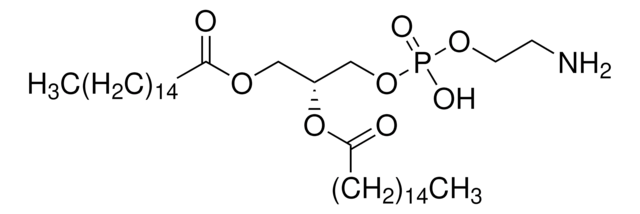850699C
Avanti
08:0 PE
1,2-dioctanoyl-sn-glycero-3-phosphoethanolamine, chloroform
Sinônimo(s):
PE(8:0/8:0)
About This Item
Produtos recomendados
Ensaio
>99% (TLC)
forma
liquid
embalagem
pkg of 1 × 1 mL (850699C-10mg)
pkg of 1 × 2.5 mL (850699C-25mg)
pkg of 1 × 20 mL (850699C-500mg)
fabricante/nome comercial
Avanti Research™ - A Croda Brand 850699C
concentração
10 mg/mL (850699C-10mg)
10 mg/mL (850699C-25mg)
25 mg/mL (850699C-500mg)
Condições de expedição
dry ice
temperatura de armazenamento
−20°C
cadeia de caracteres SMILES
[H][C@@](COP([O-])(OCC[NH3+])=O)(OC(CCCCCCC)=O)COC(CCCCCCC)=O
Descrição geral
Aplicação
Ações bioquímicas/fisiológicas
Embalagem
Informações legais
Palavra indicadora
Danger
Frases de perigo
Declarações de precaução
Classificações de perigo
Acute Tox. 3 Inhalation - Acute Tox. 4 Oral - Carc. 2 - Eye Irrit. 2 - Repr. 2 - Skin Irrit. 2 - STOT RE 1 Oral - STOT SE 3
Órgãos-alvo
Liver,Kidney, Respiratory system
Código de classe de armazenamento
6.1D - Non-combustible acute toxic Cat.3 / toxic hazardous materials or hazardous materials causing chronic effects
Classe de risco de água (WGK)
WGK 3
Ponto de fulgor (°F)
does not flash
Ponto de fulgor (°C)
does not flash
Certificados de análise (COA)
Busque Certificados de análise (COA) digitando o Número do Lote do produto. Os números de lote e remessa podem ser encontrados no rótulo de um produto após a palavra “Lot” ou “Batch”.
Já possui este produto?
Encontre a documentação dos produtos que você adquiriu recentemente na biblioteca de documentos.
Nossa equipe de cientistas tem experiência em todas as áreas de pesquisa, incluindo Life Sciences, ciência de materiais, síntese química, cromatografia, química analítica e muitas outras.
Entre em contato com a assistência técnica










